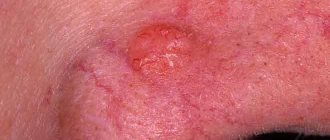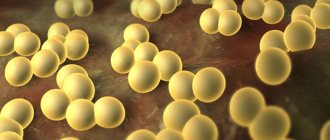Nose bleed
Nasal bleeding is called bleeding from the nasal cavity when fluid flows through the nostrils onto the face, or through the choanae to the back wall of the pharynx. There are two types of bleeding: anterior and posterior. In some cases, blood enters the nasolacrimal duct (due to a suction effect) and flows out through the orbit. This may be misleading to witnesses to the phenomenon and to first responders.
Fresh blood and blood clots can pass through the esophagus into the stomach, causing nausea or even vomiting. In extremely rare cases, nosebleeds can be fatal. Literature mentions the leader Attila, who choked on his own blood in his sleep on his wedding night.
Nasal packing is necessary to stop nosebleeds. Perhaps the loss of fluid is small, but the presence of complications makes this condition urgent.
Nosebleeds of general origin
These bleedings can be dangerous depending on the common causes, of which the most common is hypertension (50%). Bleeding of hypertensive origin is profuse in nature and can often lead to significant blood loss and hypoxic collapse if intervention is not timely.
Other causes include mitral valve stenosis, pulmonary emphysema, liver cirrhosis, kidney and blood diseases, occupational intoxication, vitamin deficiency C, Osler's disease, agranulocytosis, etc. General bleeding is difficult to stop and often recurs, causing anemia.
Causes
The choice of procedure (anterior or posterior nasal packing is required for the patient) depends on which vessels are damaged. This is the only criterion. But there are quite a few factors that can provoke bleeding. They are divided into local and system.
Local include:
- nasal injuries;
- foreign bodies;
- inflammation and swelling of the nasal mucosa.
These are the three most common factors that cause nosebleeds. There are also more exotic ones:
- anatomical deformities;
- inhalation of drugs;
- oncological processes in the nasal cavity;
- cold and dry air;
- abuse of drops for runny nose;
- barotrauma and surgery.
Systemic factors include allergies, a constant increase in blood pressure, and the presence of colds. In addition, nosebleeds are possible as a result of taking non-steroidal anti-inflammatory drugs, drinking alcohol, having problems with the coagulation system, deficiency of vitamins K and C, and systemic autoimmune diseases.
Classification and preparation
Tamponade is performed by a doctor or trained paramedic in a hospital setting.
Performing tamponade is a medical procedure. It can also be carried out by a paramedic (for example, working as part of an emergency medical team). In this case, assistants are needed (paramedic, nurse, doctor). The patient cannot and should not insert tampons into the nose on his own; this carries a risk of injury.
Anterior nasal tamponade is used for massive bleeding from the anterior and middle sections. Gauze turundas are inserted into the nose through the nostrils. In the case of posterior tamponade, it is necessary to insert a tampon closing the vessels through the mouth, using a special guide located in the nasal cavity.
How to make turundas in the nose? You need a gauze bandage, the width of which is about 3–4 cm. To get a blank for the turunda, you need to bend the edges of the bandage inward. A ribbon 1 cm wide is formed (width options of 1.5 and 2 cm are allowed). The length of the tape is up to 70 cm. It is sterilized and soaked in Vaseline oil or antibacterial ointment before use. You cannot immediately apply turundas to the nose as separate tampons. Manipulation requires the use of a long gauze strip.
For anterior tamponade, you will need a tray, tweezers and scissors (they must be sterile), as well as dressings (bandage, cotton wool), sterile wipes, hand sanitizer and gloves. For posterior tamponade - additionally a rubber catheter, gauze swab, silk threads, plaster, petroleum jelly, dressing material.
If there is an allergy, the patient should be informed before the procedure. Sometimes the use of sedatives (calming) drugs is required. If posterior tamponade is indicated, intubation anesthesia is considered.
The classification is based on the method of inserting tampons: through the nose (anterior) or through the oral cavity (posterior). The method is selected based on the location of the injured area. If the wound is located in the middle or anterior part of the nasal cavity, the tampon will be able to block it from the front.
In this case, gauze is inserted through the nostrils. If the bleeding is localized to the posterior wall of the nasal cavity, then tamponade is carried out through the mouth using auxiliary instruments.
Before anterior tamponade is performed, the surgical site must be prepared. It should contain the following items:
- sterile tweezers,
- sterile scissors,
- sterile gauze bandage,
- cotton wool,
- tray for tools and materials,
- processed napkins,
- antiseptic for hands and gloves.
The therapist should clean their hands and wear sterile gloves. The operation can be carried out either by himself or by an assistant with the necessary experience - a paramedic or nurse. Carrying out the procedure without assistants is difficult. For maximum convenience and speed, assistance is provided by a small team of 2-3 people.
For posterior nasal tamponade, specialized instruments are added:
- Vaseline oil for catheter treatment,
- catheter for inserting gauze,
- gauze swab,
- patch,
- silk threads.
Gauze must be prepared. It is impregnated with an antibacterial agent or Vaseline. The base bandage must be sterile. After processing, the bandage (selected about 4 cm wide) must be folded towards the center until it reaches a width of 1 cm.
With extensive bleeding, sizes of 1.5 and 2 cm are acceptable. The length is usually from 60 to 70 cm, depending on the age of the patient. Tampons are not cut to a minimum size because this makes them difficult to insert.
The patient himself must take a certain position before the procedure. You cannot throw your head back: this will force you to swallow your own blood, which is fraught with nausea, vomiting and general weakness of the patient. You should tilt your head forward, take a position in which it is impossible to fall due to growing dizziness.
Pathophysiology
In order for bleeding to occur, the wall of the vessel must be damaged. The nasal mucosa is very well vascularized, so even a small application of force is enough to cause blood to flow.
Nosebleeds most often occur in children under ten years of age and in people over sixty, usually men.
Against the background of high blood pressure, bleeding occurs spontaneously and can be quite prolonged if measures are not taken in time. In old age, the mucous membrane is so thin that even basic hygiene procedures can cause a vessel to rupture.
In 95% of cases, the source of bleeding is the anterior inferior part of the nasal septum. There is the so-called Kisselbach plexus. There are also “signal” bleedings. They are characterized by spontaneity, short duration and abundance. These episodes may be caused by damage to a large vessel in the face, a ruptured aneurysm, or a disintegrating tumor.
Anterior nasal packing
Anterior nasal packing for bleeding is most often used. This “love” of doctors for this procedure is caused by the fact that in the vast majority of cases the anterior vessels of the nasal cavity are damaged, and there is no need for other methods.
As a rule, such bleeding is not an independent disease. They are only symptoms of more global changes in the body. Therefore, if you experience frequent recurrent bleeding, you need to think about what other changes have occurred in your health and whether there is a reason to see a doctor.
Anterior tamponade technique
Anterior nasal tamponade is performed in the following cases:
- if there is a suspicion of the development of posterior bleeding;
- if within 15 minutes simple types of first aid for anterior bleeding (for example, a hemostatic sponge) do not give results.
So, the technique for performing anterior nasal tamponade in case of nosebleeds will be as follows.
For the procedure, you will need several tampons; these can be narrow (up to 2 cm) and long (5 cm) turundas made from a bandage. A hemostatic agent (for example, 3% hydrogen peroxide) or a small amount of petroleum jelly must be applied to the tampon. Also, anterior nasal tamponade requires a nasal speculum and tweezers to perform the manipulation.
The half of the nasal cavity where bleeding occurred is sequentially filled with prepared tampons using tweezers. You need to start manipulation from the deepest parts of the organ. For anterior nasal tamponade, an adult patient will need approximately 2-3 tampons. If necessary, the procedure is performed simultaneously with both nasal passages.
If the method turns out to be effective, then the flow of blood will stop not only from the outside (from the nostrils and the lumen of tampons), but also along the back wall of the throat, which is assessed as a result of examination with a laryngoscope.
Properly performed nasal tamponade technique provides a reliable hemostatic effect in the vast majority of cases. Often the bleeding stops not only in the front part of the nose, but also in its posterior sections, if the source of trouble was lurking there.
The essence of anterior nasal tamponade is due to the usual mechanical pressure on the part of the mucous membrane that was injured, and the additional pharmacological effect of the drug in which the tampons were soaked (most often hydrogen peroxide).
In this case, tampons are also a frame structure that reliably holds the formed blood clot or thrombus in the place where the blood vessel is damaged. Read more about what to do if a child has a nosebleed →
Etiology
There are traumatic causes of bleeding. They include injuries of any origin, including surgical interventions. There are also symptomatic causes that are associated with the manifestations of systemic diseases with the anatomical integrity of the nose.
Women experience concomitant (that is, occurring simultaneously with menstruation) and vicarious (that is, replacing menstrual function) bleeding. The mechanism of their formation has not yet been sufficiently studied.
One way or another, whatever the reasons for the appearance of blood from the nasal passages, it is imperative to stop its flow.
Methods to stop nosebleeds
Today there are many ways to stop bleeding. The choice depends on the massiveness and cause of the condition. Nasal packing does not necessarily have to be used as the primary method. The algorithm for stopping bleeding consists of the following steps:
1. Detect bleeding. 2. Determine its cause. 3. Identify the damaged vessel. 4. Stop bleeding in the most convenient and fastest way. 5. Monitor the patient’s condition.
You can relieve mild nosebleeds on your own in the following ways:
1. Nasal tamponade. The technique is simple: a cotton or gauze swab soaked in 3% hydrogen peroxide is inserted into the lumen of the nasal concha.
2. Pre-moisten a cotton swab in vasoconstrictor drops, and then insert it into the nasal passage from which blood flows.
3. Ask the patient to take a deep breath through his nose, exhale through his mouth and at the same time put ice on the bridge of his nose and the back of his head.
When performing any of the procedures, the patient must sit or take a semi-sitting position and lower his head forward. This is necessary to prevent blood from flowing down the back wall of the throat into the stomach.
Nasal tamponade
Nasal tamponade is performed for nosebleeds that do not stop after the use of conventional hemostatic agents. Anterior tamponade is most often performed, since nosebleeds in 90-95% of cases occur from the anterior nasal septum.
To carry out anterior tamponade, you need cranked tweezers or a nasal forceps, gauze turundas 1.5 cm wide, 7-8 and 20 cm long, soaked in vaseline oil, pre-warmed hemostatic paste, thrombin or hemophobin. Since the procedure is very painful, the nasal mucosa is anesthetized by spraying or instilling a 2% solution of dicaine or a 5% solution of cocaine into the nose. You can also achieve an analgesic effect by intramuscular injection of a lytic mixture: 2 ml of a 50% analgin solution and 1 ml of a 1% solution of promedol and 2% diphenhydramine. Tamponade is performed during anterior rhinoscopy. When bleeding from the anterior part of the nasal septum, several tampons 7-8 cm long are sequentially inserted into the common nasal passage, pressing the tampons against the nasal septum, between it and the inferior nasal turbinate. In case of bleeding from the middle or posterior sections of the nasal cavity or the impossibility of determining the site of bleeding, pack the entire half of the nose with a gauze turunda 20 cm long in the form of a loop into which 1-2 similar turundas are inserted. Instead of gauze turundas, dry thrombin, fibrin film, a hemostatic sponge, foam rubber with antibiotics, a rubber catheter with holes and two rubber finger caps attached to it, which are inflated after insertion into the nasal cavity, can be introduced into the nasal cavity.
Posterior nasal tamponade is performed when anterior tamponade is ineffective. For this you need a nasal forceps, cranked tweezers, a rubber catheter, a gauze swab made in the form of a bale measuring 3 x 2 cm, cross-tied with three silk threads with ends up to 15 cm long.
After intramuscular injection of the lytic mixture, a rubber catheter is inserted into the anterior nasal opening of the half of the nose from which bleeding occurs and advanced along the bottom of the nasal cavity into the nasopharynx, and then into the oropharynx until its end appears from behind the soft palate. The catheter is grabbed with a forceps and removed from the mouth. A gauze swab is tied to the withdrawn end of the catheter using 2 silk threads, after which the catheter is advanced in the opposite direction, pulling it by the end protruding from the anterior nasal opening. A gauze swab is pulled into the nasopharynx and placed at the choanae, which is controlled by a finger inserted through the oral cavity into the nasopharynx. The tampon is held in the desired position by tensioning two threads removed from the anterior nasal opening along with the catheter. The third thread (necessary for subsequent removal of the tampon) is removed from the mouth and glued to the cheek with an adhesive plaster. The posterior tamponade is complemented by the anterior one, after which silk threads protruding from the nose are tied over a gauze or cotton ball at the entrance to the nose, which holds the posterior tampon in the nasopharynx.
Tampons after anterior or posterior tamponade are left for 1-2 days, during which sulfonamide drugs or antibiotics are prescribed to prevent inflammatory diseases.
Anterior tamponade technique
If all of the above methods are ineffective, anterior nasal packing is performed. Its technique is quite simple to perform. First of all, the doctor should perform local anesthesia of the nasal cavity with a solution of lidocaine or novocaine (after conducting allergy tests, of course). Then the doctor inserts sterile gauze moistened with a hemostatic agent or Vaseline ointment into the bleeding tract. The length of the gauze can be about seventy centimeters, but the width is only one and a half. The turunda is placed in the form of an accordion so as to completely fill the nasal cavity.
This tampon is left in place for almost three days, and after this period is removed. In case of particularly severe bleeding, the gauze can be left for seven days, but in this case it must be moistened with solutions of antibiotics and aminocaproic acid.
Anterior tamponade
Anterior nasal packing is used quite often. Previously, to achieve the effect of anesthesia, the mucous membrane is lubricated with a topical anesthetic. This could be a solution of dicaine, lidocaine, etc. There are several tamponade techniques, but the generally accepted method is the Mikulicz loop method. The basis is a gauze turunda about one and a half centimeters wide. Its length can be from 60 to 70 cm. Cranked tweezers and hemostatic paste are also required. In some cases, turundas are impregnated with indifferent ointment (levomekol, Vaseline, etc.).
Anterior nasal packing
Loop packing is carried out from the vestibule of the nose to the choanae. The tampon is placed in the form of an accordion until the half of the nose from which blood flows is completely filled. In case of bilateral bleeding, tamponade of the second half is carried out in the same way. Removal of tampons begins with preliminary impregnation with a weak solution of hydrogen peroxide, usually on the third day. If bleeding resumes, the tampon is left in place for six days. During this period, it is soaked daily with a solution of penicillin, etc.
Along with gauze turundas, sterilized tampons are also used for anterior tamponade, with which the nasal cavity is tightly filled. They are more effective and are considered more gentle.
Reasons for performing posterior tamponade
Anterior nasal packing may not produce the expected results. Or the source of the bleeding may be further away than initially thought. In such cases, they resort to a more labor-intensive but effective method.
Posterior nasal packing is performed to stop nosebleeds if:
1. The patient had a direct blow to the nose or a foreign body entered the nasal passage. 2. If bleeding is caused by long-term rhinitis or sinusitis. 3. In cases where high systemic blood pressure does not allow the walls of the vessel to collapse and prevents the formation of a blood clot. 4. The cause of bleeding is a disintegrating tumor. 5. The patient has blood diseases.
Why is posterior nasal tamponade necessary?
Posterior tamponade of the nasal cavity is required in case of intense bleeding, provided that the anterior tamponade was ineffective, the volume of blood lost by the patient exceeds 1 liter, or the injured vessel or group of vessels is located further in the nasal cavity than it initially seemed. This type of nasal tamponade is more complex than the first, but also more effective.
Most often, such nosebleeds develop as a result of the following reasons::
- the patient received a strong direct blow to the nose;
- a foreign object has entered the nasal passages;
- bleeding began as a result of exacerbation of chronic rhinitis or sinusitis;
- high blood pressure prevents the collapse of vascular walls and interferes with the natural process of thrombus formation;
- a disintegrating malignant or benign neoplasm is localized in the nasal cavity;
- history of blood diseases.
Technique for performing nasal tamponade
Only a trained specialist can perform this manipulation; you should not try to self-medicate at home. In addition to the doctor, two or even three more people participate in this action. One of them is needed in order to maintain the correct position of the patient's head. The second serves swabs and helps fix them, and the third prepares new sterile swabs if necessary.
Before the procedure begins, the patient is given any sedative to relax him and reduce the gag reflex. Then a soft catheter lubricated with sterile petroleum jelly is inserted into the oral cavity through the nose. A gauze swab of the appropriate size is tied to the end of this tube. The tampon has three threads: two secure it to the catheter, and one remains in the mouth and is then attached to the cheek with a bandage. The next step is to remove the catheter through the nose. In this case, the tampon is pressed against the choanae and completely closes the nasopharynx. After this, an anterior tamponade is made and the remaining two threads are tied in front. The tampon is also removed after two to three days.
Technique for posterior nasal tamponade
Failure to achieve results after anterior tamponade requires posterior nasal tamponade. It should be noted right away that only a qualified specialist can correctly perform this technique; there can be no talk of any self-help at home.
The posterior nasal packing kit will be as follows:
- several swabs of bandage in the shape of a triangle, stitched with silk ligatures on different sides - a total of 3 threads will be needed;
- 2-3 tampons from a bandage for anterior tamponade;
- small diameter rubber catheter;
- nasal speculum;
- tweezers;
- putty knife;
- sling bandage;
- any sedative that the patient must take before the procedure.
Algorithm for nasal tamponade:
- The specialist inserts a catheter treated with petroleum jelly through the nasal passage in which the bleeding has occurred, moving it into the nasopharynx to the larynx, where he picks up the tip of the catheter with tweezers and brings it out through the mouth. It is important to ensure that the second tip of the catheter does not “go” completely into the nose.
- To the end of the catheter, which was removed through the oral cavity, ligatures of triangular tampons are tied from the “sharp” edge and they are pulled out using the catheter. In this case, the ligature threads are supported, trying to ensure that the tampon is inserted into the nasopharynx and fixed in its lumen.
- Holding the tampons in this position, the specialist performs the anterior nasal tamponade technique, and then secures the ligatures with a knot on the outside of the nose. After this, a sling-shaped bandage is applied.
After successful completion of the posterior nasal packing technique, the gauze pads must be removed very carefully to avoid resumption of bleeding. With anterior tamponade, tampons are removed on the second day, with posterior tamponade - on days 7-9. Before the procedure, it is necessary to soak the tampons with a solution of hydrogen peroxide.
Complications
Nasal tamponade, like any other manipulation, can cause complications. Among them are phenomena such as necrosis of the nasal mucosa. This occurs due to prolonged compression of blood vessels and nerves during turunda exposure. The second problem may be the exacerbation or development of purulent diseases of the sinuses (sinusitis, sinusitis), since blood and gauze provide a good environment for the proliferation of bacteria.
In severe cases, posterior tamponade can lead to deformation of the nose and nasal septum. In addition, therapy may result in the formation of a hematoma or septic melting of the septum due to the addition of a secondary infection.
Why the procedure cannot be performed at home
The main problem with tamponade is that the tampon must remain in the patient's nose for a significant period. The minimum time is 1 day, the maximum is 3 days. During this period, the tampon must also be changed (every 24 hours), trying not to break the clot or damage the mucous membranes.
The entire time a blood clot is forming, you need to stay close to a specialist. He will check for the presence of a clot and diagnose other changes in the condition. While the tampon is in the nose, you need to inhale through your nose and exhale through your mouth.
If you use unsterile bandages to create tampons, infection will occur. It will also develop if the gauze is left in the cavity for more than a day. Infectious lesions can lead to tissue necrosis and loss of the nasal septum, and other complications.










